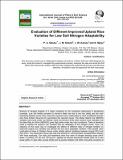| dc.description.abstract | Scarcity of nitrogen fertilizer is a major constraint to rice production particularly in developing
countries. Low soil fertility prevalent in farmer’s fields has led to low rice yields and the ever
escalating fertilizer prices have made this important input unaffordable to most smallholder farmers
who have limited resources for purchasing the required inputs. The Mwea Upland rice (MWUR)
varieties were bred under low fertilizer input environment while other authors have indicated that
the New Rice for Africa (NERICA) gives high yields under low input conditions. There is therefore
need to identify the superior rice varieties that are adaptable to low nitrogen levels. Thus, the
objective of this study was to investigate the effects of different rates of nitrogen fertilizer on
improved upland rice varieties and identify the low input adaptable varieties. Field studies were
conducted at Alupe in Western Kenya under rainfed upland conditions between August 2012 and
April 2013. The experiment layout was split plot factorial in a Randomized Complete Block Design
with three replicates. The main plot treatments were four rates of nitrogen fertilizer levels which
were; 0 (control), 40, 80 and 120 kg ha-1 applied as calcium ammonium nitrate (26% N) in two
equal splits; 21 days after sowing (DAS) and at panicle initiation (46 DAS). Sub-plots consisted ofour MWUR varieties namely MWUR 1, MWUR 2, MWUR 3, MWUR 4; and four NERICA varieties
namely NERICA 1, NERICA 4, NERICA 10 and NERICA 11. The parameters measured included
plant height, tiller number, filled grain ratio percentage and yield components. In the study, nitrogen
treatment showed significant effect on plant growth and the measured parameters increased
significantly with increase in nitrogen level. MWUR varieties studied were more adaptable to low
nitrogen conditions as compared to NERICA varieties. The NERICA varieties recorded higher yield
at high nitrogen levels as compared to MWUR varieties. However, NERICA 4 gave higher yield as
compared to other NERICA varieties regardless of the nitrogen level. Results from our study
suggest that MWUR 1 and 2 and NERICA 4 were more tolerant to low nitrogen as compared to
MWUR 3 and 4 and NERICA 1, 10 and 11, because of higher height, more tiller number, higher
filled grain ratio percentage and higher yield component as compared to the other studied varieties
and may be suitable for soils low in nitrogen. | en_US |

